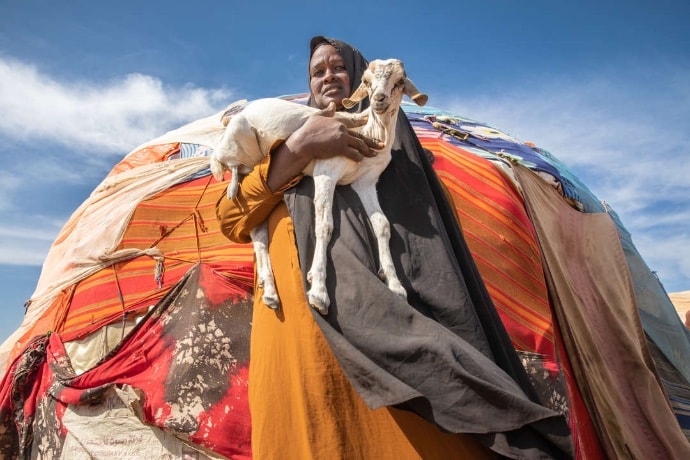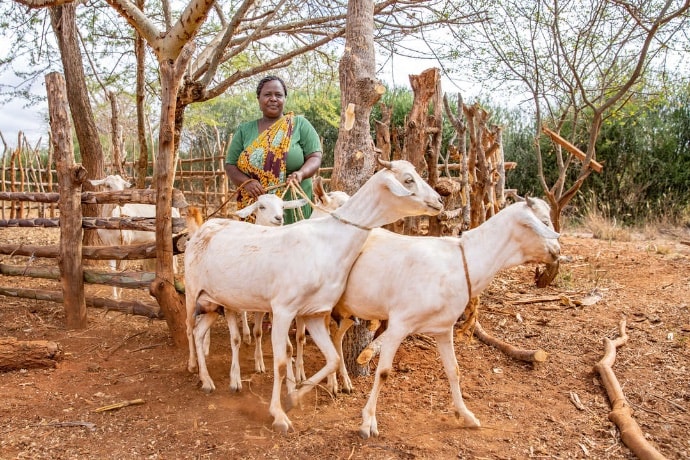By Tracey Compton, Senior Media Communications Coordinator, Mercy Corps

February 2022, Baidoa, Somalia. Dhagan Aclan Aalan holds one of her last surviving goats, in front of her family’s temporary shelter. They are staying at an IDP camp among the scrub brush outside Baidoa. Farmers are watching crops die, leaving nothing to sell or eat. Grazing land has dried up, leaving pastoralists without food or water to feed their livestock herds. As people are forced to migrate and resources are scarce, conflict is likely to increase, further disrupting food systems. Photo: Ezra Millstein/Mercy Corps
October 2024
Mercy Corps is adding a critical perspective to the livestock emissions debate, emphasizing the potential benefits of pastoralists, or those who move herds across land, in drylands and opening a pathway toward food security previously often overlooked by dominant climate narratives.
“What’s missing from climate action campaigns and commitments around livestock production? A lot,” says Carmen Jaquez, Mercy Corps Director of Evidence and Learning for Resilient Drylands Production Systems for the Horn of Africa. Current narratives are biased, lacking input from communities they seek to change – in this case, pastoralists in Africa – and failing to apply a much-needed climate justice lens. Jaquez expands upon this argument in a recently published paper in Mercy Corps Climate: Possible position paper series titled, “How livestock can advance climate adaptation and mitigation goals.” Here we take a look at some of the lessons learned.
What is Pastoralism?
Pastoralism is more than just an economic system; it’s a way of life, a cultural identity, and a production system. Mobility is the key to sustainability, as animals migrate between seasonal pastures and water points, optimizing the use of fragile dryland ecosystems. In Africa, pastoralism has long relied on the “characteristic instability” of rangeland environments to manage resources effectively. Pastoralists live across the African continent, practicing pastoralism in dryland landscapes where crop-based agriculture is not possible. It’s not that different to cattle production in U.S. Midwest and West, where animals rotate through pastures or are trucked to reach seasonal grazing areas in different parts of the country.
A Seat at the Table
Historically, pastoralist communities have been ignored and marginalized, says Jaquez. Their only recognized contributions to society were animals. They didn’t have roads, schools or a history of public investment and development.
“People haven’t appreciated what these communities contribute to society beyond their animals,” she says. “Until recently, we rarely saw investment in development efforts for pastoralists. Across the drylands, there is a history of humanitarian assistance during times of crises – a drought, for example – and little else. When you approach drylands and pastoralism as a problem that needs to be fixed, instead of recognizing a dynamic, resilient and ecologically based economy, you miss the potential and the opportunity.”
This bias has crept into the aid and climate sector, which exclude pastoralists from climate adaptation and mitigation efforts. They often do not have a seat at the table, and development organizations fail to recognize the economic and ecological potential of pastoralism as a resilient, sustainable system.
Checking our bias and holding up a mirror
Livestock production is often viewed as a major polluter, with many climate advocates advocating for reducing dependency on livestock meat and cow milk as key to solving the climate crisis. This argument deflects blame from human-caused climate change and puts the adaptation and mitigation burden on communities that did not create the problem. On average, Africans consumer less than 13 kilograms – 28 pounds – of red meat and poultry per person per year. This is compared to an estimated 126 kilograms – 277 pounds – per person per year in the United States. Greenhouse gas emissions from livestock in sub-Saharan Africa is roughly 50% of emissions for livestock in North America and less than 30% of livestock production in Latin America. So, Africa is not impacting climate change to the degree that the rest of the world is, especially when it comes to livestock production.
“Industrialized nations lead on all greenhouse gas emissions. Climate activists need to stop saying that livestock in Africa has the same problem as the rest of the world because it doesn’t. Livestock and animal source foods such as meat and milk are a key element to reducing food insecurity and malnutrition across Africa and the critical element in the drylands,” says Jaquez.
The researcher Ian Scoones, with the Institute of Development Studies, makes this point clear in his December 2023 blog for Pastres, where he argues for a more “holistic ‘systems’ approach to mitigation.”
Valuing ecosystem services for multiple outcomes
Pastoralists have long valued healthy rangelands as the foundation of their livelihoods. Mercy Corps’ recent ecosystem services valuation study reveals that pastoralists decide when and how to move animals across the landscape to prevent overuse and protect grazing areas for future use. However, pastoralists are losing control over critical rangeland resources, making them increasingly vulnerable to the impacts of climate change and driving degradation of the remaining resources. Investing in pastoralists to regain control over their resources and restore the nature-based solutions intrinsic to pastoralism is a win-win for local, national and global outcomes such as food security, poverty alleviation, sustainable food systems, climate adaptation and mitigation.

July 2019, Makindu, Kenya – Lucia, 52, takes care of her family’s goats. Her husband, Matheka Munyao, 57, relies on rain-fed agriculture to support his family, a livelihood that has become increasingly fragile with the growing effects of climate change. Photo: Ezra Millstein/Mercy Corps
Changing the Trajectory
African economies are changing. Demand for animal source foods is growing, driven largely by rapid urbanization and increasing populations. Future demand will be met through industrialized livestock production systems or meat and milk products imported through global supply chains. Both of these options remove livelihoods and economic opportunities from rural communities and increase GHG emissions from either livestock or transportation, further exasperating the climate crisis.
“Instead of moving away from livestock, those interested in climate adaptation need to double-down on investment into context-appropriate solutions co-developed with and led by pastoralist communities.” says Jaquez. She continues, “There is no silver bullet or short-term solution. African nations can learn from other parts of the world, but we can’t overlook the strength of traditional practices while working with communities to identify what and how to adapt these practices to be resilient.” she says.
“In the wet season, Africa is a carbon sink; it captures more greenhouse gases. But with urbanization, land use change and growing energy needs, Africa is increasing its emissions. Now is the time to identify and invest in climate neutral or climate beneficial solutions that leapfrog the problematic practices we see across industrialized countries. Africa is a continent of innovation and entrepreneurship. Why can’t the climate community lead on sustainable livestock systems that enable while benefiting from healthy ecosystems? Those committed to this work can improve food security and alleviate poverty in the drylands through nature-based solutions that include livestock, as long as pastoralists are part of the conversation, political will exists and there is supportive investment.”
Pastoralism and a Just Transition
Pastoralism must be prioritized in the global transition to climate-resilient food systems. Achieving sustainable development goals in Africa’s drylands will not be possible without support for pastoralism, including the continuation of mobility (livestock migration) that supports rangeland regeneration and restored rangeland health. “If climate champions don’t look to what is strong and resilient within the system and build from there and build together,” Jaquez concludes, “we are wasting money and disrespecting the very people we claim to want to help.”
Pastoralists did not cause the climate crisis, but they face some of the greatest impacts of changing and unpredictable weather patterns and increasing surface temperatures – factors that increase the vulnerability of what is traditionally one of the most resilient livelihood systems on the planet. Mercy Corps seeks to reframe the livestock narrative with a climate justice lens, recognizing the contributions of African livestock producers and their critical role in achieving food security and other global development goals.